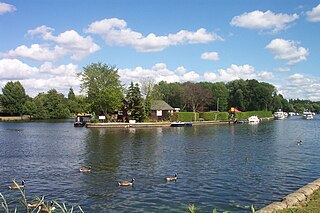




Bossoms Boatyard is located opposite Port Meadow, Oxford, England, on the bank of the River Thames. [1]





Bossoms Boatyard is located opposite Port Meadow, Oxford, England, on the bank of the River Thames. [1]
The yard was managed by the Bossom family from about 1830 until 1945, when the last in a line of several generations retired from the family business. Boats continue to be built by the company at this site to this day. [2]
Bossoms was one of the first boat builders to develop the use of GRP for hulls. They specialise in building both sailcraft and craft with electric motors and are one of the few boat builders still in existence that exhibited at the first ever London Boat Show. [2] [ dead link ]
Some of the craft built by Bossoms [3] include:

The GP14 is a wooden or fibreglass hulled double-handed fractional Bermuda rigged sailing dinghy designed by Jack Holt in 1949.

The Laser is a class of single-handed, one-design sailing dinghies using a common hull design with three interchangeable rigs of different sail areas, appropriate to a given combination of wind strength and crew weight. Bruce Kirby designed the Laser in 1970 with an emphasis on simplicity and performance.
Jack Holt, OBE was a prolific designer of sailing dinghies. His pioneering designs of dinghies using plywood did much to popularise the sport of sailing in the period immediately following World War II.

The Thistle is an American planing sailing dinghy that was designed by Sandy Douglass as a one-design racer and first built in 1945.

A Bermuda rig, Bermudian rig, or Marconi rig is a configuration of mast and rigging for a type of sailboat and is the typical configuration for most modern sailboats. This configuration was developed in Bermuda in the 1600s; the term Marconi, a reference to the inventor of the radio, Guglielmo Marconi, became associated with this configuration in the early 1900s because the wires that stabilize the mast of a Bermuda rig reminded observers of the wires on early radio masts.

Fry's Island, also known as De Montfort Island, is an island in the River Thames in England. The island is on the reach above Caversham Lock at Reading, Berkshire. The centre of Reading is to the south and the suburb of Caversham to the immediate north.

The International 505 is a One-Design high-performance two-person monohull planing sailing dinghy, with spinnaker, utilising a trapeze for the crew.
Knud Olsen was a Danish builder and designer of boats, who designed one of the most popular sailing dinghies in use over the past 50 years, the OK Dinghy, which became an ISAF International Class in 1974.

The International 14 is a British racing sailboat, crewed by two sailors. The class was established in 1928.

Raven's Ait is an ait (island) in the Thames between Surbiton, Kingston and Hampton Court Park in the Royal Borough of Kingston upon Thames, London, England, in the reach of the river above Teddington Lock. Used as a boating training centre for many years, Raven's Ait is currently privately run as a catering facility and a conference and wedding venue.

The Minto Sailing Dinghy is a sailing dinghy first produced commercially in the early 1960 and still in production.

The Coypu is a class of small sailing dinghy. It is a highly stable boat, suitable for beginners, and is normally sailed by two people, although three can be accommodated comfortably.

The CL 16, or CL16, is a Canadian sailing dinghy that was designed by Ian Proctor, Graham Dodd and George Blanchard, as a cruiser and daysailer, and first built in 1968.

The Spaulding Marine Center, , in Sausalito, California, is a living museum where one can go back in time to experience the days when craftsmen and sailors used traditional skills to build, sail or row classic wooden boats on San Francisco Bay.
Archibald Arch Logan was a New Zealand sailing yacht designer who was a leading figure in New Zealand yachting from approximately 1895 until his death. The Arch Logan Memorial Trophy named in his honour is the premier trophy of the New Zealand M class centreboard racing dinghy sailing completions.
The Vertue Class of yacht is a 25'3" length design by Laurent Giles dating from 1936, when Andrillot was launched. The class was not named Vertue until 1946: it collected the name in the wake of the win by Epeneta - a boat built to the design - of the Little Ship Club's 'Vertue Cup' In 1939 the Epeneta had completed a cruise from The Solent to Belle Île in Southern Brittany and back in only 19 days. The Vertue Cup, donated by Michael Vertue to the Little Ship Club in 1927, is given for the best log of a cruise longer than a week by a member of the club.

Francis Charles Morgan-Giles was a boat designer and builder from Devon, England. He built rowing boats, dinghies, yachts and large motor cruisers. His boats were known for their high quality, elegance and craftsmanship.

The Minisail is a 13-foot single-handed dinghy which was designed by Ian Proctor in 1959 and became popular in the 1960s. It was the predecessor to the Topper and was the first British production boat to popularise the idea of the "sailing surfboard". As the Topper gained popularity in the 1980s, the Minisail disappeared from the scene. However, on 28 August 2011, a group of enthusiasts restarted the Minisail Class Association, which now has a small but committed following mainly in north-west Europe.
Herbert Woods was an English boat builder and mooring developer from Potter Heigham, Norfolk.
The Tech Dinghy is an American sailing dinghy that was designed by George Owen, a professor at Massachusetts Institute of Technology (MIT), as a one-design racer and for sail training. It was first built in 1935.
51°45′50″N1°16′51″W / 51.7640°N 1.2809°W